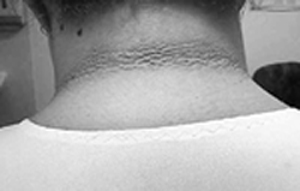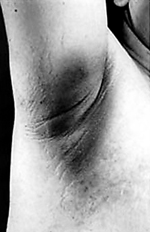|
The right
diet
Worried about diabetes? Healthy eating habits
and regular exercise will get you far. Here are some guidelines
to help you
A diet is the cornerstone in prevention and management
of diabetes. There is no special ‘diabetic diet’. It
is similar to that recommended for the general population and is
a healthy way of eating that the whole family can enjoy.
 |
| Signs of diabetes - If your neck looks like
this, it’s time to take some serious steps |
=Eat regular meals throughout the day (at least
three meals per day)
Avoid missing meals
Breakfast is essential
=Maintain the healthy BMI (18.5 – 22.9)
=Undertake regular physical activities (at least 30 minutes of moderate
exercise most days per week)
=Avoid eating large meals
=Drink plenty of water
=Enjoy a variety of foods (different foods contain different amounts
of nutrients) by including foods in all food groups daily
* Cereals, starchy foods
* Fruits and vegetables
* Milk and dairy foods
* Meat, fish, pulses, etc.
* Nuts, fat and sugar
 |
| Signs of diabetes - If your underarm looks
like this, it’s time to take some serious steps |
=Eat an adequate amount of rice, rice flour preparations,
starch foods and other cereals at least three times a day. They
are high in fibre and slowly absorbed. This has a low-moderate glycaemic
index
=Eat less bread and other wheat flour preparations
=Avoid or take sweet foods less frequently and in smaller amounts,
as they have a high glycaemic index due to rapid absorption. Consume
with fibre rich meals
=Eat fruits and vegetables (five portions a day), including red,
yellow, green and two from any other form
=Eat more pulses (dhal, mung, cowpea, soya, etc.) fish or sprats,
a moderate amount of poultry and eggs and little meat. Pulses have
a low glycaemic index
=Consume only moderate amounts of fat (less saturated fat and include
mono-unsaturated and poly-unsaturated fats in equal amounts)
=Consume milk or milk products daily
=Avoid intake of cholesterol rich foods frequently and in large
amounts
=Limit salt intake and salty foods
=Avoid alcoholic beverages, and if taken, never on an empty stomach
=Eat naturally occurring foods in preference to processed food
= Beware of irresponsible marketing of sugar-based food and drink
for children and pregnant women
= Beware of appropriate weight for one’s height and the concept
of Body Mass Index (BMI) that can be cross checked by your midwife/MOH/family
doctor
The glycaemic index is a measure of the change
in blood glucose, following ingestion of carbohydrate-containing
foods. The glycaemic load of a food is the product of the glycaemic
index of the food and the amount of carbohydrate in a serving. Glycaemic
index is useful only when comparing different foodstuffs within
the same food group and should not be used as an isolated concept.
=Need for physical exercise and lifestyle modification
Why is physical activity important?
Physical activity helps build and maintain healthy
bones, muscles and joints. In addition, physically active people
and children enjoy other health benefits, such as,
=Weight control
=Lower blood pressure
=Improved psychological well-being
=Regular physical activity in adulthood reduces the risk of heart
disease and Type II diabetes mellitus
Screening for Type II diabetes mellitus
General population:
=All persons over the age of 18 years should be screened, if with
risk factors, and repeated every three years
=Screen adults over the age of 45 years, annually
High risk groups are those with:
=Family history
=Obesity
=Previous history of gestational diabetes – pregnancy-induced
diabetes
=Hypertension – high blood pressure
=Cardio vascular disease
=Dyslipidemia – abnormal lipid composition in blood
=Polycystic ovary syndrome
Screening to be perform-ed through
=Fasting blood glucose (Normal – below 100 mg/dl and frank
diabetes over 125 mg/dl; 100-125 mg/dl be considered as a high risk
category (pre-diabetic stage)
=Two-hour post 75g glucose test where necessary
(Based on Food-based Dietary Guidelines
for Sri Lankans (Department of Nutrition, Ministry of Health, Sri
Lanka, 2000) from which the following excerpts have been revised
and highlighted by the group)
|

